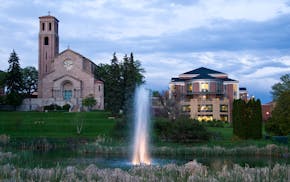DULUTH — A segment of the first rail line that connected Duluth to the world is back in action, offering fresh views of a river landscape transformed by environmental cleanup.
The volunteer-led Lake Superior & Mississippi Railroad, which for decades offered seasonal rides along the St. Louis River, has been out of commission for several years, first for the pandemic and then for major remediation and restoration work in the Spirit Lake portion of the river and at the former site of U.S. Steel in Morgan Park. The heritage railroad began offering rides again last week, taking passengers on a 6-mile, 90-minute journey through western Duluth's Indigenous roots, industrial past and recreational future.
"Riding the train will give you a firsthand view of all the work they've done," said longtime conductor and board member Harold Dols. "It's unrecognizable."
A new waterfront trail section is under construction along the Superfund site, which will coexist with the rail line that now ends at Boy Scout Landing. But the city trail isn't yet open, so that part of the river can only be seen by boat or rail.
Railroad volunteers used the long break to improve tracks, refine their historical and river cleanup stories for passengers and restore the coach and open-air "safari" cars. The engine is on loan from Wisconsin Great Northern Railroad in Trego, Wis., while the wheels of their locomotive are being refurbished.
The original Lake Superior & Mississippi Railroad first reached Duluth from St. Paul in 1870, connecting goods shipped on the Mississippi River to Lake Superior, and thus, East Coast markets. Before that, Dols said, a rudimentary road was the only way.
The line was used until the 1970s and by then, the railroad had been absorbed by another. In 1980, the Lake Superior & Mississippi Railroad tourist train nonprofit formed, the city's first.
The train route hugs the river and travels over it, showcasing islands sacred to the Fond du Lac Band of Lake Superior Chippewa — whose ancestors migrated to the region hundreds of years ago in search of manoomin, or wild rice — and sites that have undergone extensive cleanup, both to land and water.
Efforts to restore the river and remove it from a national list of polluted waterways have been ongoing for more than three decades. U.S. Steel was among the companies dumping toxic waste directly into the river, long before wastewater treatment and other regulations existed. The practice first began in the 1870s when the Duluth Harbor canal opened to allow ship traffic.
Started in 2020, the largest and most complex contamination removal project involves the section of river next to the U.S. Steel site that closed in 1981. More than 1.3 million cubic yards of toxic river bottom were dredged, nearly 120 acres of river were covered with clean sand and a sheltered bay for fish spawning was created.
With millions poured into restoration work and a healthier river to show for it, the train route is a gem, Dols said.
"The wildlife that's returned to the area is extraordinary," he said, citing lynx, bears and turtles. "When we make our runs through there, every time I just pinch myself. You can't believe you're in a major city."
The train will ferry passengers on weekend days into October and offer charters during the week.
The nonprofit is happy to be part of local and national efforts to revitalize the riverfront, board member David Bolgrien said, including city efforts to expand trails, build fishing piers and improve parks and water access.
More area residents and visitors are discovering the estuary's paddling routes and trails because of it, he said, and the train is "right in the middle" of the river's revival.

Minnesota House to debate putting equal rights, abortion protections on the ballot in 2026
Brawl erupts at Northtown Mall carnival, officer injured while intervening
Authorities search for missing kayaker who left alone on a central Minnesota lake
Anglers hope to unlock the mysteries of Minnesota's oddest, oldest fish


